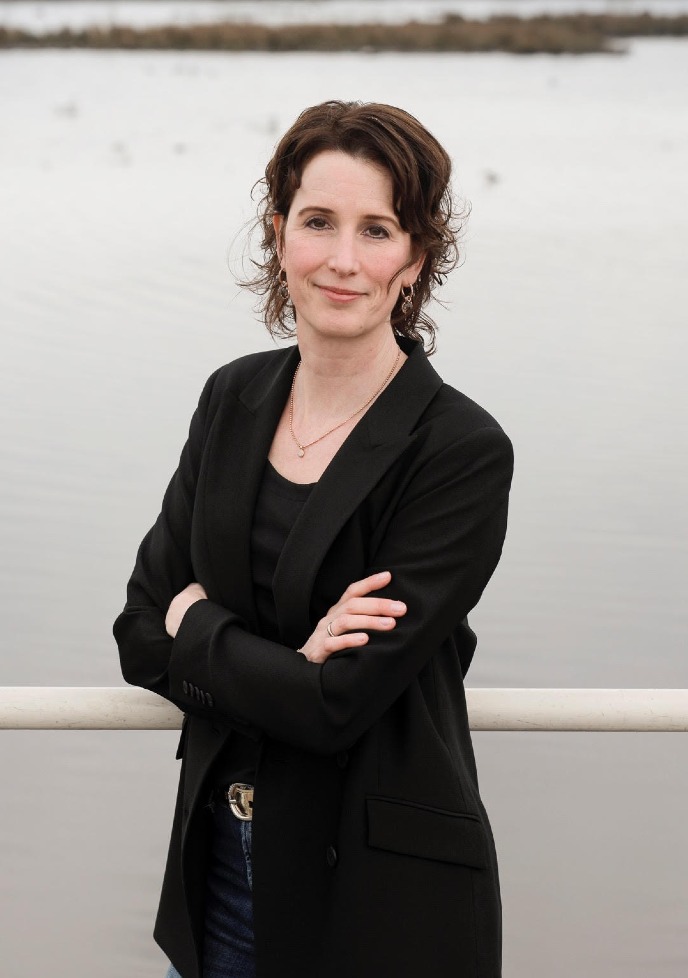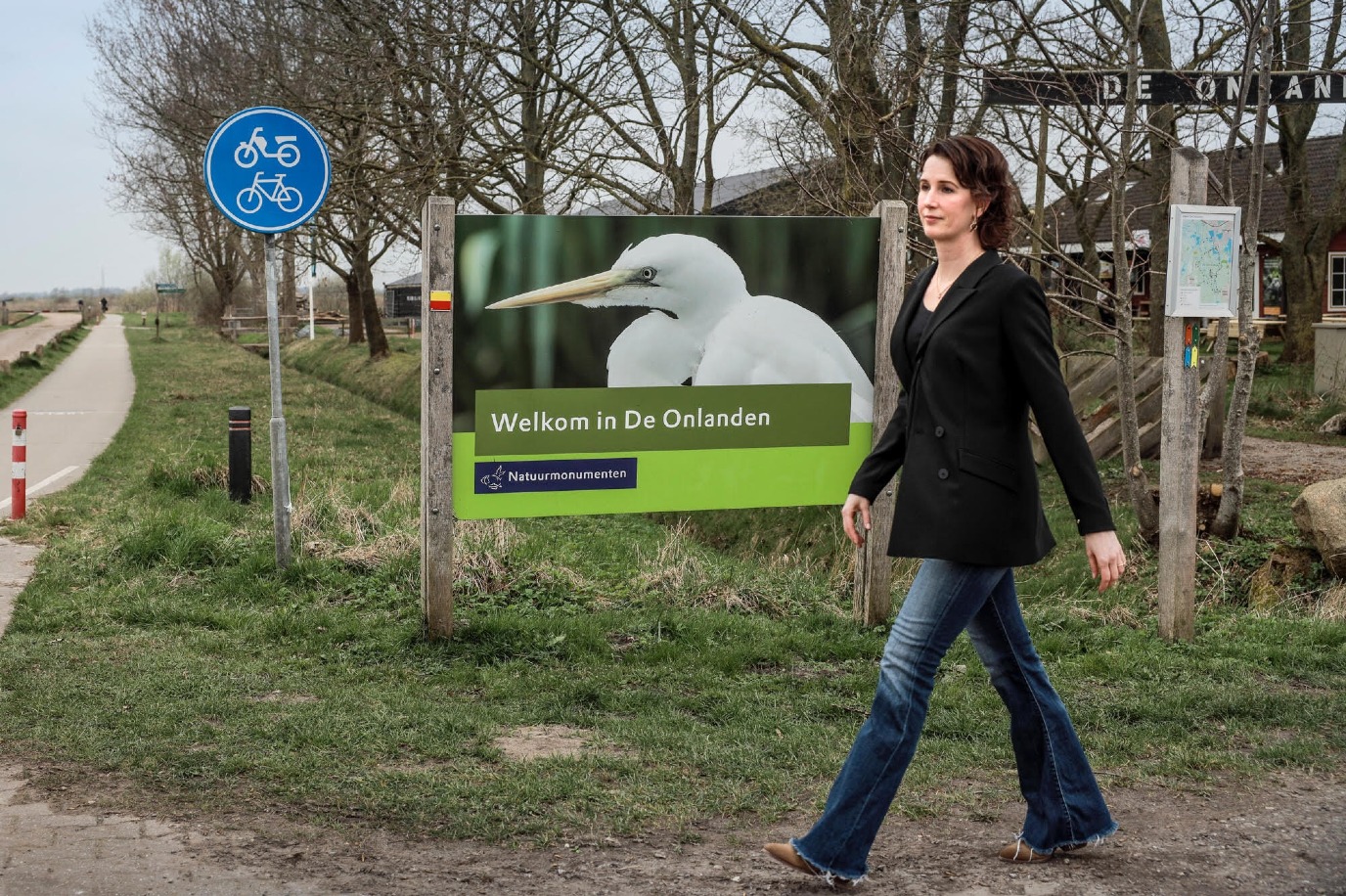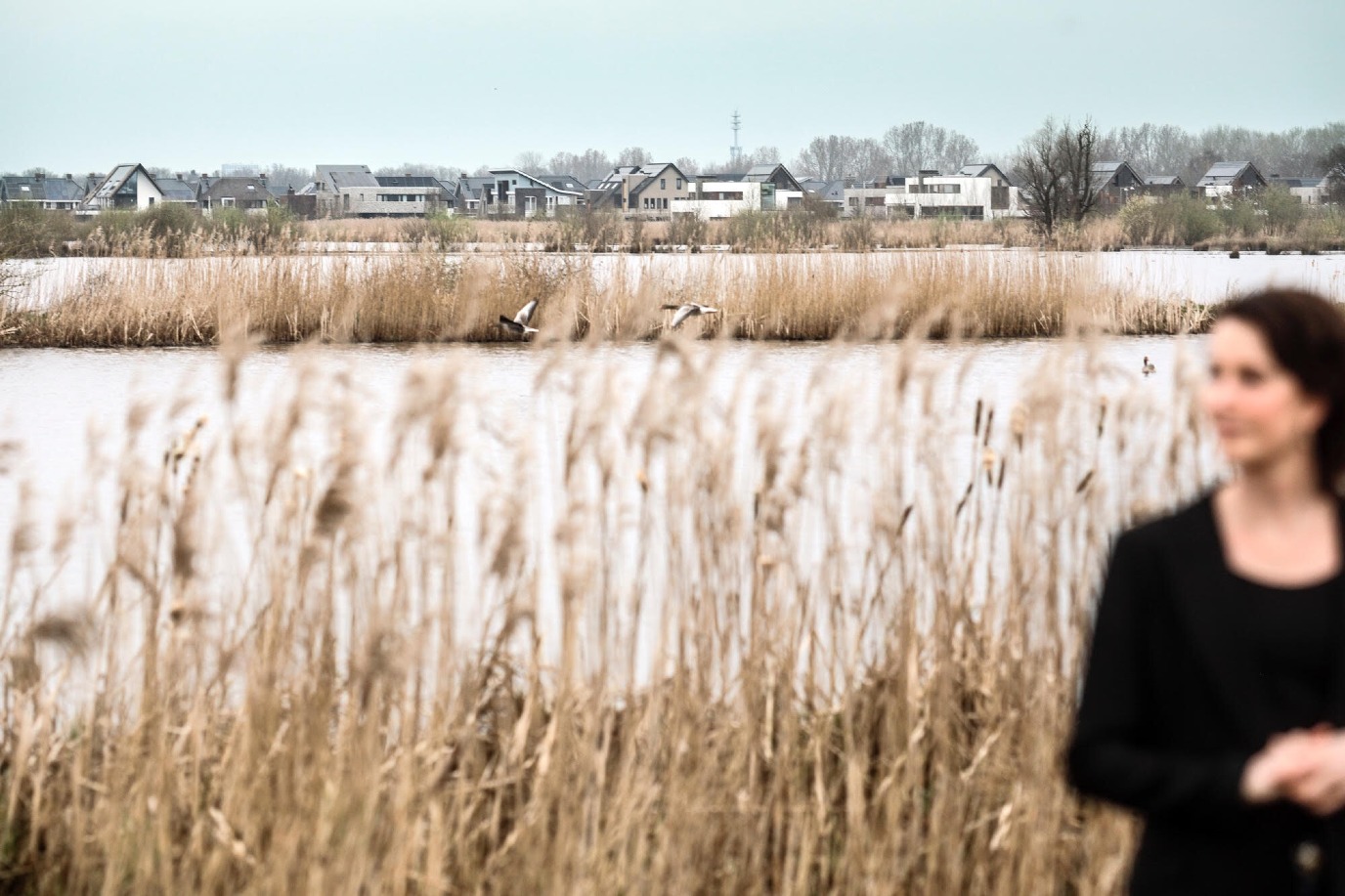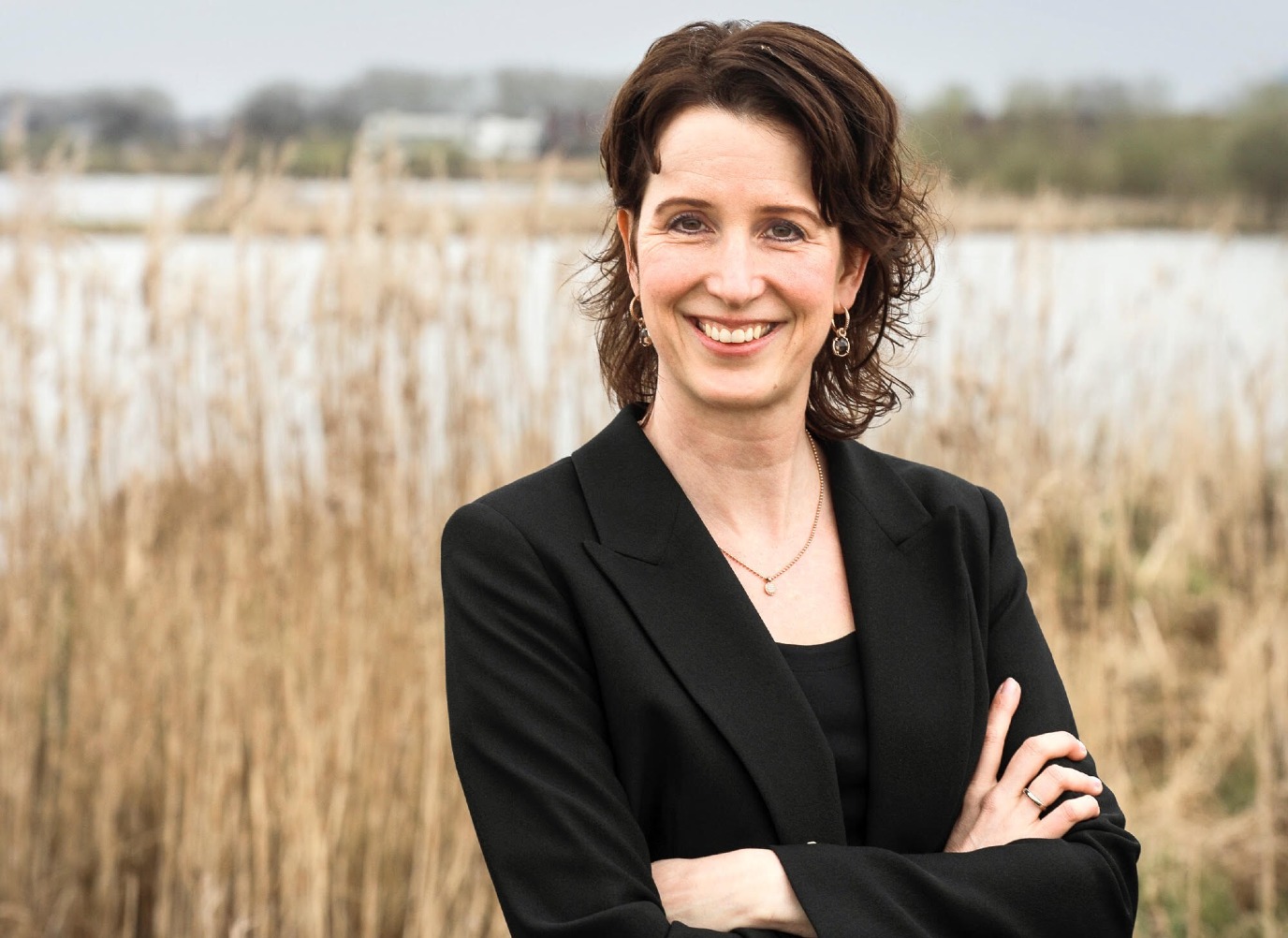Van vechten tegen het water naar leven met het water | Interview with dr. Margo van den Brink, universitair hoofddocent Water en Ruimte

Extreme buien, hittegolven, overstromingen en een stijgende zeespiegel zijn bedreigingen voor onze laaggelegen delta. Margo van den Brink, universitair hoofddocent Water en Ruimte, stelt dat we onze ruimtelijke inrichting moeten aanpassen aan het veranderende klimaat. Dat impliceert moeilijke keuzes, immers de ruimte is beperkt en de behoeftes zijn groot. Volgens haar is hier sprake van een transitie: van ‘vechten tegen het water’ naar ‘leven met het water’.
Tekst: Martin Althof, Corporate Communicatie / Foto’s: Henk Veenstra
Transitie
Van den Brink is al sinds haar studie cultuurwetenschappen in Maastricht geïnteresseerd in de transitie die gaande is in waterbeheer en -beleid om de gevolgen van de klimaatverandering het hoofd te bieden. ‘Deze interesse is ontstaan tijdens mijn stage bij de toenmalige Dienst Weg- en Waterbouwkunde van Rijkswaterstaat. Daar was ik voor het eerst getuige van een groeiende twijfel over de houdbaarheid van onze eeuwenoude strijd tegen het water met dijken en andere waterkerende kunstwerken. Alleen inzetten op traditioneel technisch waterbeheer werd in toenemende mate als onvoldoende beschouwd. Dijken blijven nodig, maar het inzicht groeide dat voor meer overstromingsveerkracht ook meer ruimte voor water nodig is.’
Ruimte voor de Rivier
Van den Brink vertelt dat een en ander tot uiting kwam in het vernieuwende project ‘Ruimte voor de Rivier’, dat werd gestart na de grote overstromingen in 1993 en 1995, toen het waterpeil in de grote rivieren tot verontrustende hoogte steeg. Natuurlijk werden de dijken toen verhoogd en verbeterd. Maar er gebeurde meer: ‘Een omvangrijk programma om het rivierengebied veiliger én aantrekkelijker te maken, dus om zowel de waterveiligheid als de ruimtelijke kwaliteit van het rivierengebied te verbeteren. Ruimtelijke maatregelen stonden centraal. De rivieren kregen letterlijk meer ruimte, door dijken te verleggen, uiterwaarden te verlagen of uit te graven, nevengeulen te graven en gebieden te ontpolderen. Overigens is na de wateroverlast in 1998 om dezelfde reden vlakbij de stad Groningen het waterbergingsgebied De Onlanden ingericht.’

Zo kan het ook
Ruimte voor de Rivier is vrijwel afgerond en Van den Brink is erg blij met de resultaten: ‘Niet alleen omdat we erin zijn geslaagd om de overstromingsrisico’s te beperken, maar zeker ook omdat op veel plaatsen de ruimtelijke kwaliteit is verhoogd. Denk daarbij aan natuurontwikkeling, aandacht voor cultuurhistorie en het scheppen van recreatiemogelijkheden. In het project werkten alle betrokken partijen nauw samen, onder centrale regie. Dat pakte goed uit. Ik vind het erg leuk dat ik binnenkort een bijdrage mag leveren aan een boek dat gaat over wat we kunnen leren van overheidssuccessen, waarvan “Ruimte voor de Rivier” er dus een is. De werktitel van het boek is “Zo kan het ook”.’
Hoogwaterbeschermingsprogramma
Ook hier geldt echter dat in het verleden behaalde resultaten geen garantie bieden voor de toekomst. In het actuele Hoogwaterbeschermingsprogramma (het HWBP), de grootste dijkversterkingsoperatie sinds de Deltawerken, is de dubbeldoelstelling waterveiligheid én ruimtelijke kwaliteit losgelaten. ‘De ondertitel van het programma is “voor sterke dijken”. We zetten hier naar mijn idee echt een stap terug, terug naar een focus op technische dijkversterkingsmaatregelen, terug naar een focus op waterveiligheid. Ruimtelijke kwaliteit is geen hoofddoelstelling meer, maar wordt nu grotendeels overgelaten aan de afzonderlijke projectteams. Daar zijn de ruimtelijke expertise en de financiële middelen vooralsnog vaak beperkt, wat in de praktijk leidt tot sobere dijkversterkingsprojecten.’

Blijvende aandacht voor ruimtelijke kwaliteit
Om die reden hebben de universiteiten van Groningen en Wageningen het initiatief genomen om verder onderzoek te doen naar de vraag wat ruimtelijke kwaliteit is en hoe ruimtelijke kwaliteit geborgd kan worden in het planproces van waterveiligheidsprojecten. Ook andere partijen, zoals verschillende waterschappen, advies- en ontwerpbureaus, vonden dit belangrijk en hebben meegefinancierd. Het onderzoek is net afgerond met de presentatie van een interactief adviesrapport. Van den Brink: ‘Het is echt tijd voor wat wij noemen een “kwaliteitskering”, zowel in letterlijke als in figuurlijke zin. Het is daarbij belangrijk om naar de kwaliteit van totale dijklandschappen te kijken en dus niet alleen naar de dijk als waterkering. Ook helpt een sterkere verankering van ruimtelijke kwaliteit als doelstelling echt, zowel op project- als op programmaniveau. Expliciete aandacht voor ruimtelijke kwaliteit en integrale gebiedsontwikkeling bieden kansen voor het creëren van draagvlak en het zoeken naar innovatieve oplossingen en financieringsmogelijkheden. Essentieel hiervoor is wel het creëren van gedeeld eigenaarschap tussen alle betrokken partijen in een gebied. Dit betekent ook iets voor de werkwijze en cultuur van oudsher technische organisaties zoals Rijkswaterstaat en de waterschappen, die zich als “gebiedspartner” veel proactiever zullen moeten gaan opstellen. Ook is ruimtelijke kennis en expertise nodig, en mensen die in staat zijn om een integrerende rol te spelen in een projectteam. Mensen die kunnen luisteren en verbinden, ik noem dat “grenswerkers”.’
Floating Future
Dat laatste geldt ook zeker voor het nieuwe interdisciplinaire onderzoeksproject waar Van den Brink aan werkt, Floating Future, dat wordt gefinancierd door NWO. ‘MARIN, het Maritime Research Institute Netherlands, heeft de regie in dit project, dat een looptijd heeft van vijf jaar en waar heel veel verschillende partijen aan meedoen. De centrale vraag is hoe we samen een fundament kunnen leggen onder een drijvende toekomst. Is het bijvoorbeeld mogelijk om grootschalig te wonen op het water? Woonboten kennen we natuurlijk allemaal. Maar hier gaat het om opschaling, dus om bijvoorbeeld een appartementengebouw, of zelfs een woonwijk op het water, op een drijvend platform. Aan deze opschaling zitten allerlei aspecten die nader onderzocht moeten worden: hoe kan dit technisch mogelijk worden gemaakt? Hoe zit het juridisch, ecologisch en bestuurlijk? En uiteraard, is het economisch haalbaar? Een belangrijke vraag is ook of mensen wel drijvend willen wonen, met andere woorden hoe staat het met de maatschappelijke acceptatie? In Groningen gaan we vooral hiernaar onderzoek doen, dus hoe drijvend wonen een aantrekkelijk toekomstperspectief zou kunnen worden voor potentiële bewoners en gebruikers, en dan niet alleen voor de ‘happy few’. En naar hoe deze opschaling beleidsmatig te organiseren.’

Alle partijen erbij betrekken
Meer dan ooit lijkt het pure noodzaak om in dit vernieuwende project alle partijen erbij te betrekken. Van den Brink: ‘We gaan de mogelijkheden voor een drijvende toekomst dus niet als onderzoekers zelf op de tekentafel schetsen. We gaan de drijvende toekomst juist samen met alle potentiële gebruikers, bewoners, vertegenwoordigers van overheden, groepen stakeholders, op een interactieve manier verkennen en vormgeven. Gedurende het onderzoek zullen we hen dan ook op veel verschillende manieren betrekken om zo gezamenlijk, via co-creatie, stappen te zetten. Samen met de Hanze gaan we bijvoorbeeld “Climate Cafe’s” organiseren.’ Van den Brink realiseert zich dat dat alles tijd gaat kosten: ‘Een stad op zee is nog een brug te ver. Het ligt voor de hand om te beginnen in en dichtbij de stad, daar waar de maatschappelijke acceptatie en haalbaarheid waarschijnlijk het grootst is.
Meer informatie
-
Onderzoeksrapport 'Ruimtelijke Kwaliteit in Waterveiligheidsbeheer’
-
Interactief adviesrapport 'Tijd voor een kwaliteitskering!'

